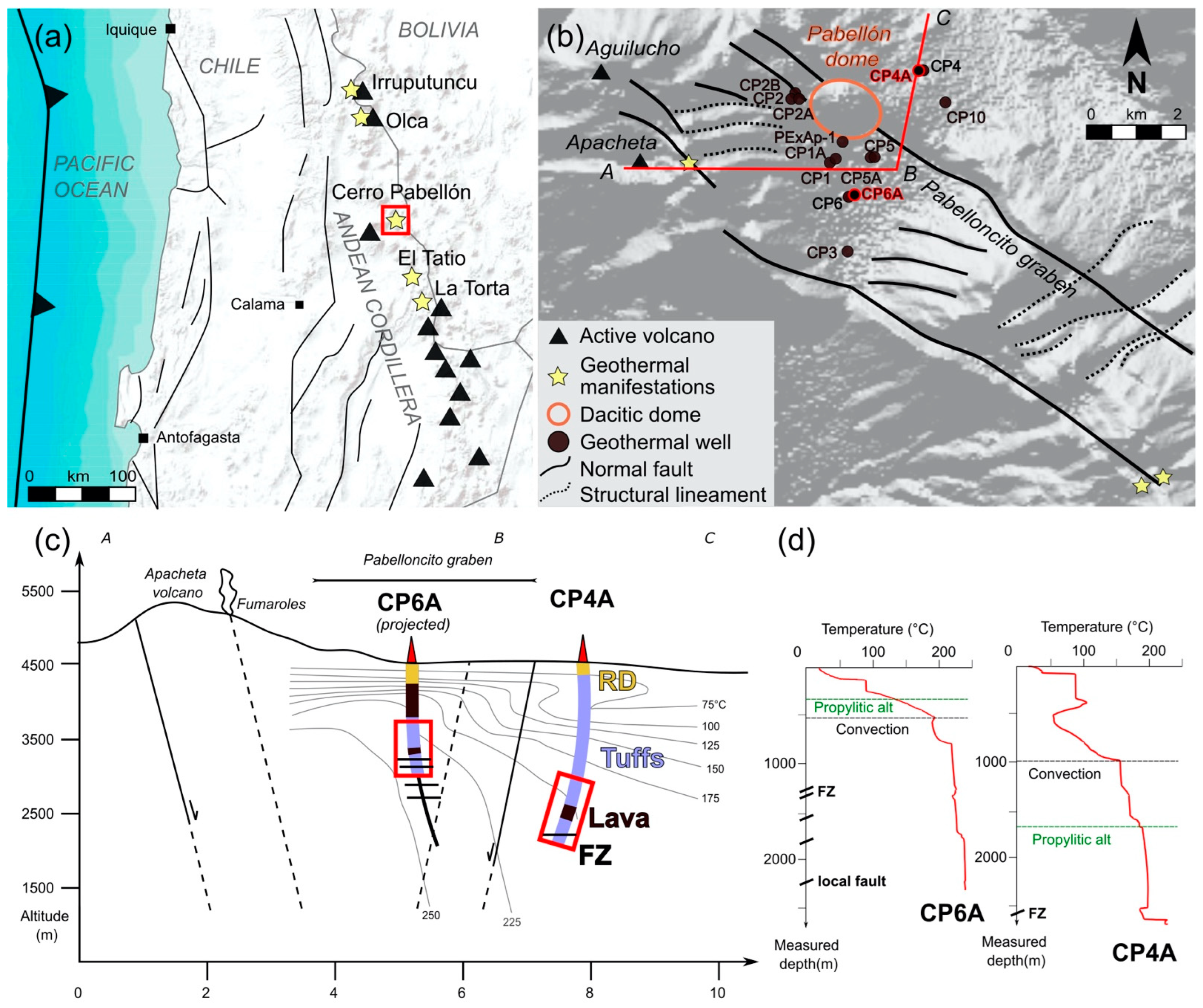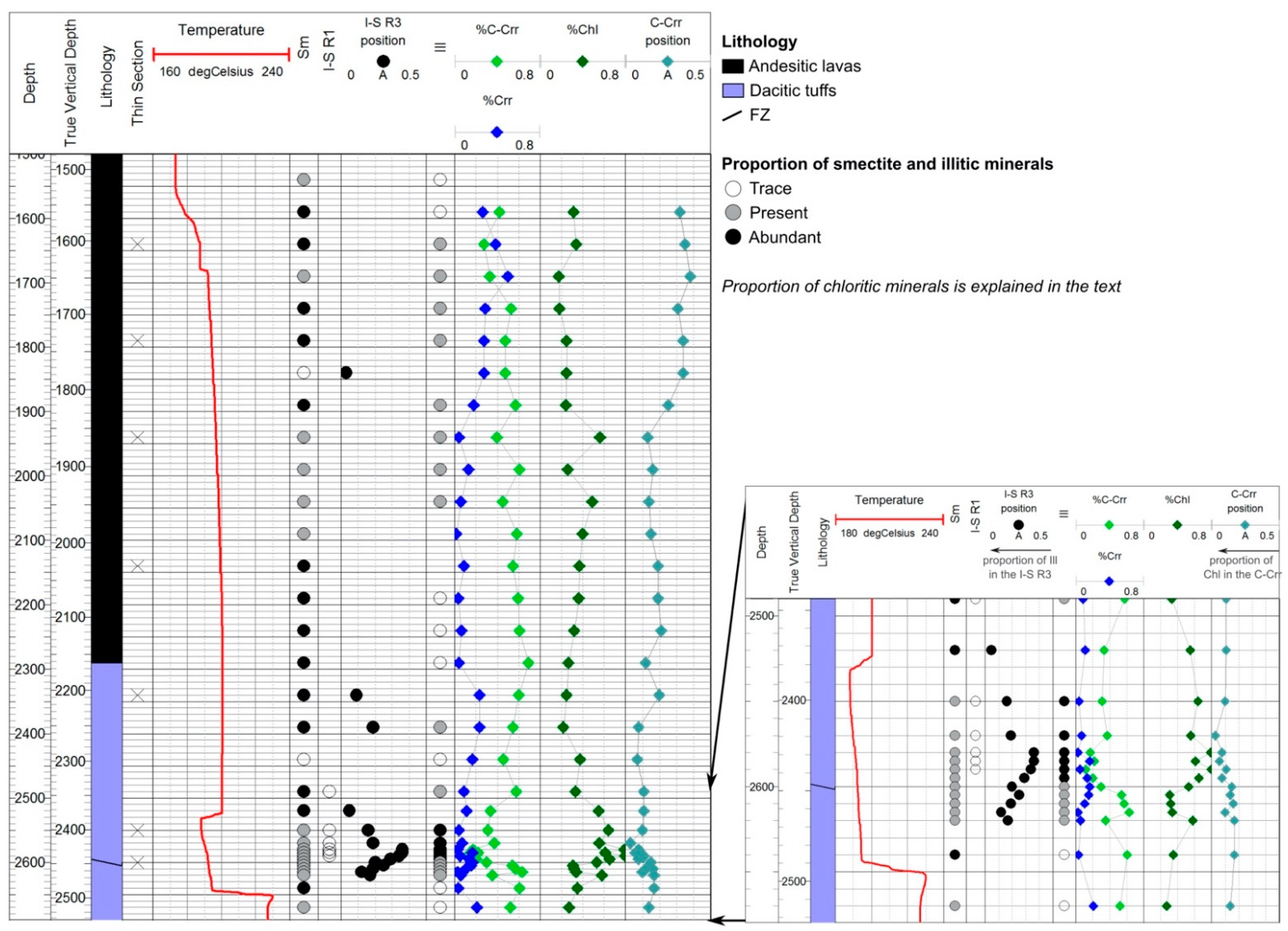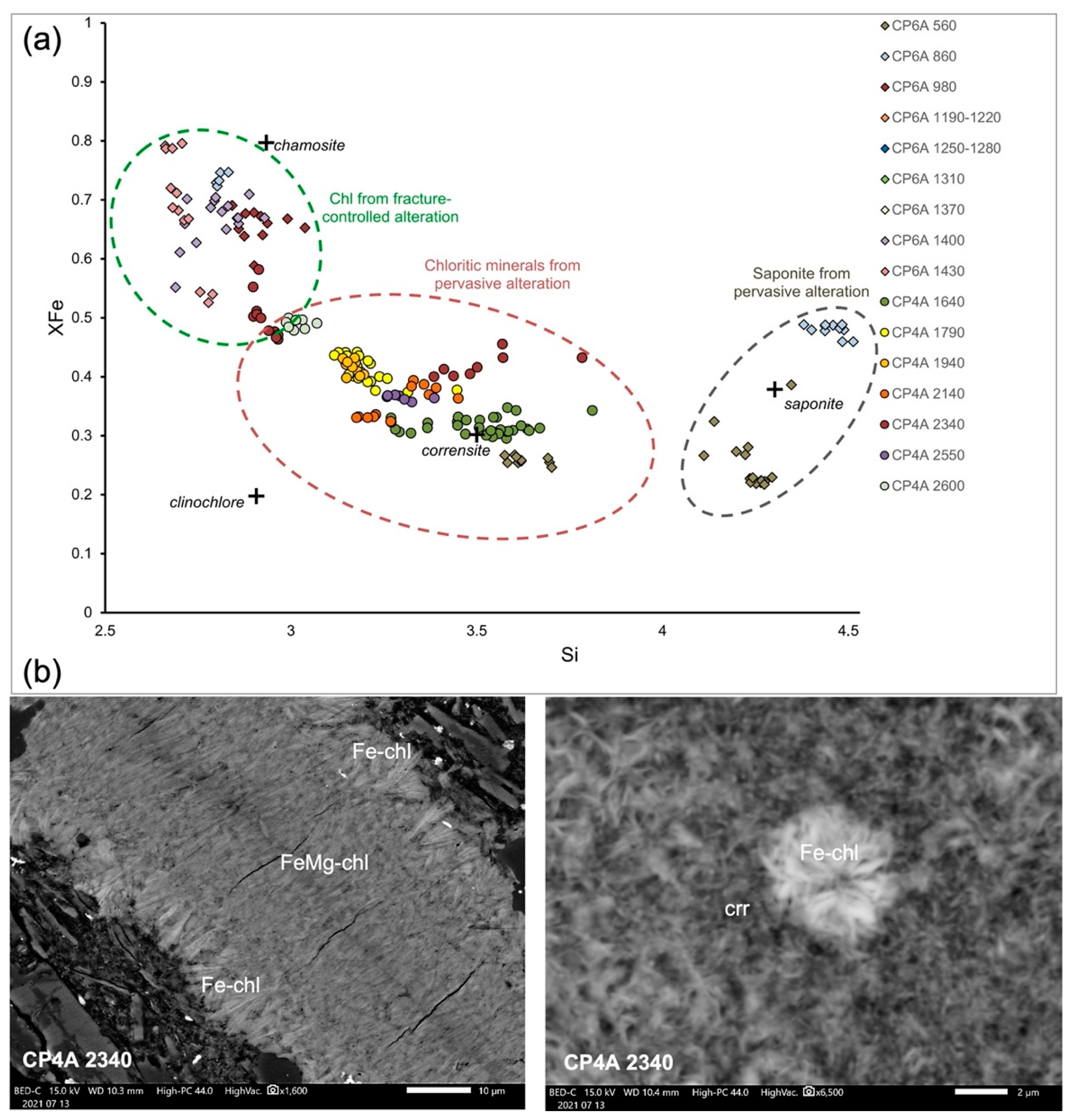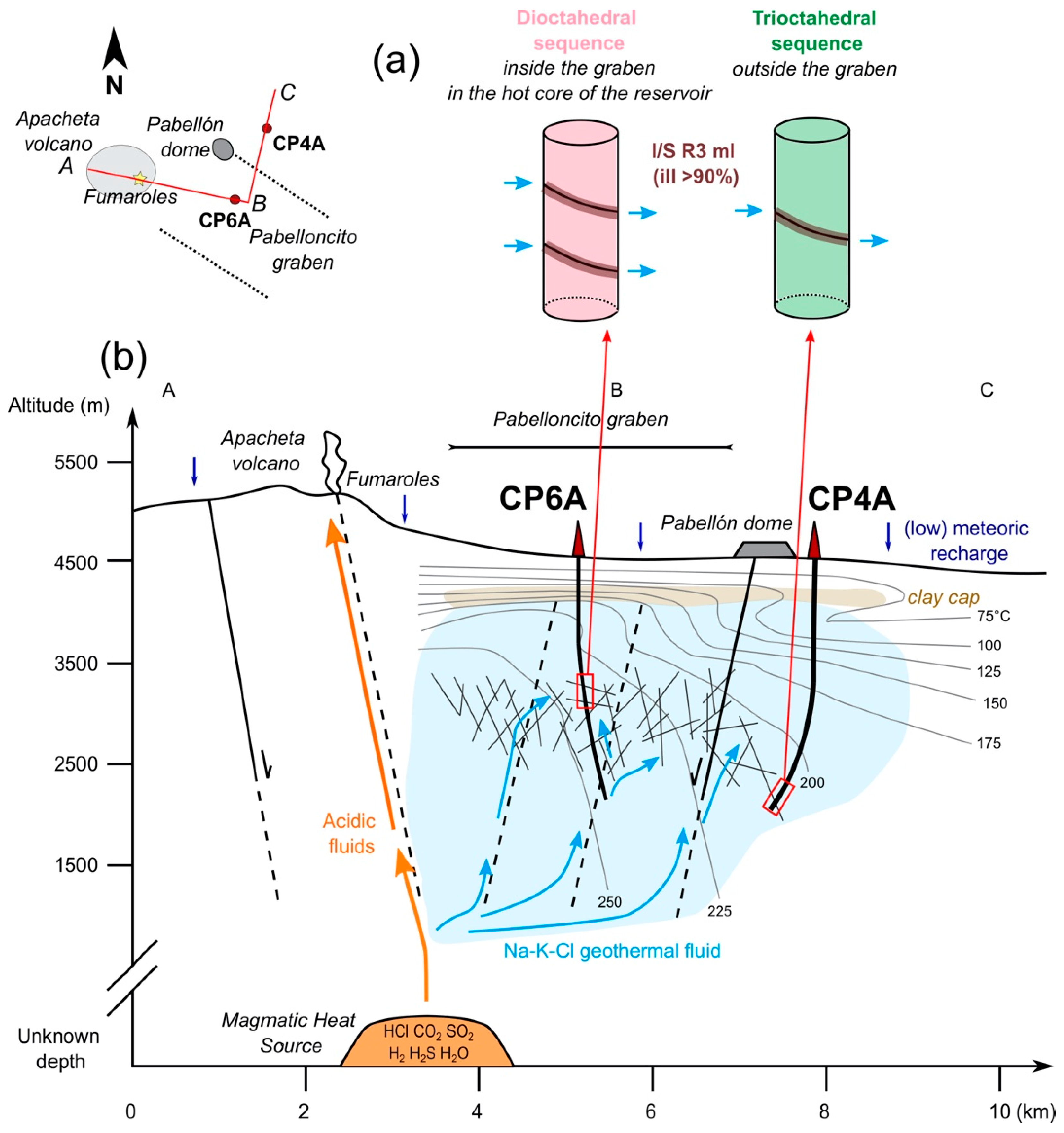Clay Minerals in the Deep Reservoir of the Cerro Pabellón Geothermal System (Northern Chile)
Abstract
1. Introduction
2. Geological Settings
- CP-4A, drilled outside the graben, where isotherms suddenly decrease, traducing cooler temperatures;
- CP-6A, drilled inside the graben in the hot core of the reservoir (Figure 1b,c).
3. Sampling and Methods
4. Results
4.1. Alteration Petrography
4.2. Depth-Related Distribution of Clay Minerals
4.2.1. Trioctahedral Clays Related to Pervasive Alteration
4.2.2. Dioctahedral Clays Related to Fracture-Controlled Alteration
4.3. Crystal Chemistry of Clay Minerals
5. Discussion
5.1. Clay Signature of the Hydrothermal Alteration
- Corrensite–Fe-Mg chlorite + epidote + titanite + quartz + hematite observed as the replacement of primary minerals as well as of the vitreous matrix in the deepest samples of the reservoir.
5.2. Towards a Conceptual Model of the Deep Fluid Circulations
6. Conclusions
Supplementary Materials
Author Contributions
Funding
Data Availability Statement
Acknowledgments
Conflicts of Interest
Abbreviations
References
- Aravena, D.; Muñoz, M.; Morata, D.; Lahsen, A.; Parada, M.Á.; Dobson, P. Assessment of High Enthalpy Geothermal Resources and Promising Areas of Chile. Geothermics 2016, 59, 1–13. [Google Scholar] [CrossRef]
- Stern, C. Active Andean Volcanism: Its Geologic and Tectonic Setting. Rev. Geol. Chile 2004, 31, 161–206. [Google Scholar] [CrossRef]
- Procesi, M. Geothermal Potential Evaluation for Northern Chile and Suggestions for New Energy Plans. Energies 2014, 7, 5444–5459. [Google Scholar] [CrossRef]
- Urzúa, L.; Powell, T.; Cumming, W.B.; Dobson, P. Apacheta, a New Geothermal Prospect in Northern Chile. Trans. Geotherm. Resour. Counc. 2002, 26, 65–69. [Google Scholar]
- Cappetti, G.; Giorgi, N.; Arias, A.; Volpi, G.; Rivera, G.; Cei, M.; Fedeli, M.; Di Marzio, G.; Pasti, M.; Massei, S.; et al. The Cerro Pabellón Geothermal Project (Chile): From Surface Exploration to Energy Production. In Proceedings of the World Geothermal Congress 2020+1, Reykjavik, Iceland, 24–27 October 2021. [Google Scholar]
- Maza, S.N.; Collo, G.; Morata, D.; Lizana, C.; Camus, E.; Taussi, M.; Renzulli, A.; Mattioli, M.; Godoy, B.; Alvear, B.; et al. Clay Mineral Associations in the Clay Cap from the Cerro Pabellón Blind Geothermal System, Andean Cordillera, Northern Chile. Clay Miner. 2018, 53, 117–141. [Google Scholar] [CrossRef]
- Taussi, M.; Nisi, B.; Pizarro, M.; Morata, D.; Veloso, E.A.; Volpi, G.; Vaselli, O.; Renzulli, A. Sealing Capacity of Clay-Cap Units above the Cerro Pabellón Hidden Geothermal System (Northern Chile) Derived by Soil CO2 Flux and Temperature Measurements. J. Volcanol. Geotherm. Res. 2019, 384, 1–14. [Google Scholar] [CrossRef]
- Beaufort, D.; Westercamp, D.; Legendre, O.; Meunier, A. The Fossil Hydrothermal System of Saint Martin, Lesser Antilles: Geology and Lateral Distribution of Alterations. J. Volcanol. Geotherm. Res. 1990, 40, 219–243. [Google Scholar] [CrossRef]
- Reyes, A.G. Petrology of Philippine Geothermal Systems and the Application of Alteration Mineralogy to Their Assessment. J. Volcanol. Geotherm. Res. 1990, 43, 279–309. [Google Scholar] [CrossRef]
- Mas, A.; Patrier, P.; Beaufort, D.; Genter, A. Clay-Mineral Signatures of Fossil and Active Hydrothermal Circulations in the Geothermal System of the Lamentin Plain, Martinique. J. Volcanol. Geotherm. Res. 2003, 124, 195–218. [Google Scholar] [CrossRef]
- Patrier, P.; Bruzac, S.; Pays, R.; Beaufort, D.; Bouchot, V.; Verati, C.; Gadalia, A. Occurrence of K-Feldspar-Bearing Hydrothermal Breccias in the Bouillante Geothermal Field (Basse Terre–Guadeloupe). Bull. Société Géologique Fr. 2013, 184, 119–128. [Google Scholar] [CrossRef]
- Glaas, C.; Vidal, J.; Patrier, P.; Girard, J.-F.; Beaufort, D.; Petit, S.; Genter, A. How Do Secondary Minerals in Granite Help Distinguish Paleo- from Present-Day Permeable Fracture Zones? Joint Interpretation of SWIR Spectroscopy and Geophysical Logs in the Geothermal Wells of Northern Alsace. Available online: https://www.hindawi.com/journals/geofluids/2019/8231816/ (accessed on 18 December 2019).
- Prasetyo, I.; Koestono, H.; Thamrin, H. Clay Alteration Study from Wells of Tompaso Geothermal Field, North Sulawesi, Indonesia. In Proceedings of the World Geothermal Congress 2015, Melbourne, Australia, 19 April 2015. [Google Scholar]
- Teklemariam, M.; Battaglia, S.; Gianelli, G.; Ruggieri, G. Hydrothermal Alteration in the Aluto-Langano Geothermal Field, Ethiopia. Geothermics 1996, 25, 679–702. [Google Scholar] [CrossRef]
- Vidal, J.; Patrier Mas, P.; Betancourt, C.; Maza, S.; Morata, D. First Results of the Vein Alteration in the Deep Well PGC1 of Irruputuncu Geothermal System, Andean Cordillera, Northern Chile. In Proceedings of the World Geothermal Congress 2020+1, Reykjavik, Island, 24–27 October 2021. [Google Scholar]
- Vásquez, M.; Nieto, F.; Morata, D.; Droguett, B.; Carrillo-Rosua, F.J.; Morales, S. Evolution of Clay Mineral Assemblages in the Tinguiririca Geothermal Field, Andean Cordillera of Central Chile: An XRD and HRTEM-AEM Study. J. Volcanol. Geotherm. Res. 2014, 282, 43–59. [Google Scholar] [CrossRef]
- Flexser, S. Hydrothermal Alteration and Past and Present Thermal Regimes in the Western Moat of Long Valley Caldera. J. Volcanol. Geotherm. Res. 1991, 48, 303–318. [Google Scholar] [CrossRef]
- Inoue, A.; Kitagawa, R. Morphological Characteristics of Illitic Clay Minerals from a Hydrothermal System. Am. Mineral. 1994, 79, 700–711. [Google Scholar]
- Patrier, P.; Papapanagiotou, P.; Beaufort, D.; Traineau, H.; Bril, H.; Rojas, J. Role of Permeability versus Temperature in the Distribution of the Fine (<0.2 Μm) Clay Fraction in the Chipilapa Geothermal System (El Salvador, Central America). J. Volcanol. Geotherm. Res. 1996, 72, 101–120. [Google Scholar] [CrossRef]
- Vásquez, M.; Bauluz, B.; Nieto, F.; Morata, D. Illitization Sequence Controlled by Temperature in Volcanic Geothermal Systems: The Tinguiririca Geothermal Field, Andean Cordillera, Central Chile. Appl. Clay Sci. 2016, 134, 221–234. [Google Scholar] [CrossRef]
- Beaufort, D.; Papapanagiotou, P.; Patrier Mas, P.; Fouillac, A.M.; Traineau, H. I/S and C/S Mixed Layers, Some Indicators of Recent Physical-Chemical Changes in Active Geothermal Systems: The Case Study of Chipilapa (El Salvador). In Proceedings of the Seventeenth Workshop on Geothermal Reservoir Engineering, Stanford University, Stanford, CA, USA, 22–24 January 1996. [Google Scholar]
- Maza, S.N.; Collo, G.; Morata, D.; Taussi, M.; Vidal, J.; Mattioli, M.; Renzulli, A. Active and Fossil Hydrothermal Zones of the Apacheta Volcano: Insights for the Cerro Pabellón Hidden Geothermal System (Northern Chile). Geothermics 2021, 96, 102206. [Google Scholar] [CrossRef]
- Maza, S.N.; Collo, G.; Morata, D.; Cuña-Rodriguez, C.; Taussi, M.; Renzulli, A. The Hydrothermal Alteration of the Cordón de Inacaliri Volcanic Complex in the Framework of the Hidden Geothermal Systems within the Pabelloncito Graben (Northern Chile). Minerals 2021, 11, 1279. [Google Scholar] [CrossRef]
- Rivera, G.; Morata, D.; Ramirez, C.; Volpi, G. Volcanic and Tectonic Evolution of Azufre–Inacaliri Volcanic Chain and Cerro Pabellón Geothermal Field (Northern Chile). In Proceedings of the World Geothermal Congress 2020+1, Reykjavik, Iceland, 24–27 October 2021. [Google Scholar]
- Taussi, M.; Nisi, B.; Vaselli, O.; Maza, S.; Morata, D.; Renzulli, A. Soil CO2 Flux and Temperature from a New Geothermal Area in the Cordón de Inacaliri Volcanic Complex (Northern Chile). Geothermics 2021, 89, 101961. [Google Scholar] [CrossRef]
- Tibaldi, A.; Corazzato, C.; Rovida, A. Miocene–Quaternary Structural Evolution of the Uyuni–Atacama Region, Andes of Chile and Bolivia. Tectonophysics 2009, 471, 114–135. [Google Scholar] [CrossRef]
- Tibaldi, A.; Bonali, F.L. Contemporary Recent Extension and Compression in the Central Andes. J. Struct. Geol. 2018, 107, 73–92. [Google Scholar] [CrossRef]
- Veloso, E.E.; Tardani, D.; Elizalde, D.; Godoy, B.E.; Sánchez-Alfaro, P.A.; Aron, F.; Reich, M.; Morata, D. A Review of the Geodynamic Constraints on the Development and Evolution of Geothermal Systems in the Central Andean Volcanic Zone (18–28 Lat.S). Int. Geol. Rev. 2019, 62, 1294–1318. [Google Scholar] [CrossRef]
- Giordano, G.; Pinton, A.; Cianfarra, P.; Baez, W.; Chiodi, A.; Viramonte, J.; Norini, G.; Groppelli, G. Structural Control on Geothermal Circulation in the Cerro Tuzgle–Tocomar Geothermal Volcanic Area (Puna Plateau, Argentina). J. Volcanol. Geotherm. Res. 2013, 249, 77–94. [Google Scholar] [CrossRef]
- Godoy, B.; Wörner, G.; Kojima, S.; Aguilera, F.; Simon, K.; Hartmann, G. Low-Pressure Evolution of Arc Magmas in Thickened Crust: The San Pedro–Linzor Volcanic Chain, Central Andes, Northern Chile. J. S. Am. Earth Sci. 2014, 52, 24–42. [Google Scholar] [CrossRef]
- Morata, D.; Maza, S.N.; Vidal, J.; Taussi, M.; Renzulli, A.; Mattioli, M.; Pizarro, M.; Camus, E.; Godoy, B.; Alvear, B.; et al. Hydrothermal Alteration in Cerro Pabellón Geothermal Field: From Surface and Drill Core Data to Conceptual Model. In Proceedings of the World Geothermal Congress 2020+1, Reykjavik, Iceland, 24–27 October 2021. [Google Scholar]
- Tassi, F.; Aguilera, F.; Darrah, T.; Vaselli, O.; Capaccioni, B.; Poreda, R.J.; Delgado Huertas, A. Fluid Geochemistry of Hydrothermal Systems in the Arica-Parinacota, Tarapacá and Antofagasta Regions (Northern Chile). J. Volcanol. Geotherm. Res. 2010, 192, 1–15. [Google Scholar] [CrossRef]
- Giudetti, G.; Tempesti, L. First Geochemical Data from Cerro Pabellón Geothermal Project (Apacheta Region, Chile). In Proceedings of the World Geothermal Congress 2020+1, Reykjavik, Iceland, 24–27 October 2021. [Google Scholar]
- Baccarin, F.; Volpi, G.; Rivera, G.; Giorgi, N.; Arias, A.; Giudetti, G.; Cei, M.; Cecioni, M.; Rojas, L.; Ramirez, C. Cerro Pabellón Geothermal Field (Chile): Geoscientific Feature and 3D Geothermal Model. In Proceedings of the World Geothermal Congress 2020+1, Reykjavik, Iceland, 24–27 October 2021. [Google Scholar]
- Morata, D.; Reich, M.; Muñoz-Saez, C.; Daniele, L.; Rivera, G.; Volpi, G.; Cecioni, M.; Giudetti, G.; Cappetti, G. Origin and Age of Fluids at the Cerro Pabellón Geothermal System, Northern Chile. In Proceedings of the 41st New Zealand Geothermal Workshop, Auckland, New Zealand, 25–27 November 2019. [Google Scholar]
- Bradford, J.; McLennan, J.; Moore, J.; Glasby, D.; Waters, D.; Kruwells, R.; Bailey, A.; Rickard, W.; Bloomfield, K.; King, D. Recent Developments at the Raft River Geothermal Field. In Proceedings of the Thirty-Eighth Workshop on Geothermal Reservoir Engineering, Stanford University, Stanford, CA, USA, 11 February 2013. [Google Scholar]
- Davatzes, N.C.; Hickman, S.H. Controls on Fault-Hosted Fluid Flow; Preliminary Results from the Coso Geothermal Field, CA. In Proceedings of the Geothermal Resources Council Transactions, Geothermal Resources Council, Davis, CA, USA, 25 September 2005; Volume 29, pp. 343–348. [Google Scholar]
- Genter, A.; Evans, K.; Cuenot, N.; Fritsch, D.; Sanjuan, B. Contribution of the Exploration of Deep Crystalline Fractured Reservoir of Soultz to the Knowledge of Enhanced Geothermal Systems (EGS). C. R. Geosci. 2010, 342, 502–516. [Google Scholar] [CrossRef]
- Vidal, J.; Hehn, R.; Glaas, C.; Genter, A. How Can Temperature Logs Help Identify Permeable Fractures and Define a Conceptual Model of Fluid Circulation? An Example from Deep Geothermal Wells in the Upper Rhine Graben. Geofluids 2019, 2019, 3978364. [Google Scholar] [CrossRef]
- Vidal, J.; Genter, A.; Chopin, F. Permeable Fracture Zones in the Hard Rocks of the Geothermal Reservoir at Rittershoffen, France. J. Geophys. Res. Solid Earth 2017, 122, 4864–4887. [Google Scholar] [CrossRef]
- Brindley, G.W.; Brown, G. X-Ray Diffraction Procedures for Clay Mineral Identification. In Crystal Structures of Clay Minerals and Their X-ray Identification; Brindley, G.W., Brown, G., Eds.; Mineralogical Society: London, UK, 1980; Volume 5, pp. 305–360. ISBN 978-0-903056-37-3. [Google Scholar]
- Wilson, M.J. Rock-Forming Minerals, Sheet Silicates–Clay Minerals, 2nd ed.; The Geological Society: London, UK, 2013; Volume 3C. [Google Scholar]
- Foster, M.D. Studies of Celadonite and Glauconite. USGS Numbered Series. Prof. Pap. 1969, 614F, F1–F17. [Google Scholar] [CrossRef]
- Beaufort, D.; Baronnet, A.; Lanson, B.; Meunier, A. Corrensite; A Single Phase or a Mixed-Layer Phyllosilicate in Saponite-to-Chlorite Conversion Series? A Case Study of Sancerre-Couy Deep Drill Hole (France). Am. Mineral. 1997, 82, 109–124. [Google Scholar] [CrossRef]
- Moore, D.M.; Reynolds, R.C. Identification of Clay Minerals and Associated Minerals, 2nd ed.; Oxford University Press: Oxford, UK, 1997. [Google Scholar]
- Koyama, K. Takeuchi Clinoptilolite: The Distribution of Potassium Atoms and Its Role in Thermal Stability. Z. Für Krist.-Cryst. Mater. 1977, 145, 216–239. [Google Scholar] [CrossRef]
- Mansouri, N.; Rikhtegar, N.; Panahi, H.A.; Atabi, F.; Shahraki, B.K. Porosity, Characterization and Structural Properties of Natural Zeolite-Clinoptilolite-as a Sorbent. Environ. Prot. Eng. 2013, 39, 139–152. [Google Scholar]
- Lowell, J.D.; Guilbert, J.M. Lateral and Vertical Alteration-Mineralization Zoning in Porphyry Ore Deposits. Econ. Geol. 1970, 65, 373–408. [Google Scholar] [CrossRef]
- Thomasson, J.; Kristmannsdottir, H. High Temperature Alteration Minerals and Thermal Brines, Reykjanes, Iceland. Contrib. Mineral. Petrol. 1972, 36, 123–134. [Google Scholar] [CrossRef]
- Beaufort, D.; Patrier, P.; Meunier, A.; Ottaviani, M.M. Chemical Variations in Assemblages Including Epidote and/or Chlorite in the Fossil Hydrothermal System of Saint Martin (Lesser Antilles). J. Volcanol. Geotherm. Res. 1992, 51, 95–114. [Google Scholar] [CrossRef]
- López-Munguira, A.; Nieto, F.; Morata, D. Chlorite Composition and Geothermometry: A Comparative HRTEM/AEM-EMPA-XRD Study of Cambrian Basic Lavas from the Ossa Morena Zone, SW Spain. Clay Miner. 2002, 37, 267–281. [Google Scholar] [CrossRef][Green Version]
- Mas, A.; Guisseau, D.; Patrier Mas, P.; Beaufort, D.; Genter, A.; Sanjuan, B.; Girard, J.P. Clay Minerals Related to the Hydrothermal Activity of the Bouillante Geothermal Field (Guadeloupe). J. Volcanol. Geotherm. Res. 2006, 158, 380–400. [Google Scholar] [CrossRef]
- Beaufort, D.; Rigault, C.; Billon, S.; Billault, V.; Inoue, A.; Inoue, S.; Patrier, P. Chlorite and Chloritization Processes through Mixed-Layer Mineral Series in Low-Temperature Geological Systems—A Review. Clay Miner. 2015, 50, 497–523. [Google Scholar] [CrossRef]
- Gorini, A.; Ridolfi, F.; Piscaglia, F.; Taussi, M.; Renzulli, A. Application and Reliability of Calcic Amphibole Thermobarometry as Inferred from Calc-Alkaline Products of Active Geothermal Areas in the Andes. J. Volcanol. Geotherm. Res. 2018, 358, 58–76. [Google Scholar] [CrossRef]
- Vidal, J.; Patrier, P.; Genter, A.; Beaufort, D.; Dezayes, C.; Glaas, C.; Lerouge, C.; Sanjuan, B. Clay Minerals Related to the Circulation of Geothermal Fluids in Boreholes at Rittershoffen (Alsace, France). J. Volcanol. Geotherm. Res. 2018, 349, 192–204. [Google Scholar] [CrossRef]
- Glaas, C.; Patrier, P.; Vidal, J.; Beaufort, D.; Genter, A. Clay Mineralogy: A Signature of Granitic Geothermal Reservoirs of the Central Upper Rhine Graben. Minerals 2021, 11, 479. [Google Scholar] [CrossRef]
- Nieto, F.; Abad, I.; Bauluz, B.; Reolid, M. Textural and Genetic Relationships between Glauconite and Celadonite at the Nanoscale: Two Different Structural-Compositional Fields. J. Eur. J. Mineral. 2021, 33, 503–517. [Google Scholar] [CrossRef]








Publisher’s Note: MDPI stays neutral with regard to jurisdictional claims in published maps and institutional affiliations. |
© 2022 by the authors. Licensee MDPI, Basel, Switzerland. This article is an open access article distributed under the terms and conditions of the Creative Commons Attribution (CC BY) license (https://creativecommons.org/licenses/by/4.0/).
Share and Cite
Vidal, J.; Patrier, P.; Beaufort, D.; Maza, S.; Rivera, G.; Volpi, G.; Morata, D. Clay Minerals in the Deep Reservoir of the Cerro Pabellón Geothermal System (Northern Chile). Minerals 2022, 12, 1244. https://doi.org/10.3390/min12101244
Vidal J, Patrier P, Beaufort D, Maza S, Rivera G, Volpi G, Morata D. Clay Minerals in the Deep Reservoir of the Cerro Pabellón Geothermal System (Northern Chile). Minerals. 2022; 12(10):1244. https://doi.org/10.3390/min12101244
Chicago/Turabian StyleVidal, Jeanne, Patricia Patrier, Daniel Beaufort, Santiago Maza, Germain Rivera, Gianni Volpi, and Diego Morata. 2022. "Clay Minerals in the Deep Reservoir of the Cerro Pabellón Geothermal System (Northern Chile)" Minerals 12, no. 10: 1244. https://doi.org/10.3390/min12101244
APA StyleVidal, J., Patrier, P., Beaufort, D., Maza, S., Rivera, G., Volpi, G., & Morata, D. (2022). Clay Minerals in the Deep Reservoir of the Cerro Pabellón Geothermal System (Northern Chile). Minerals, 12(10), 1244. https://doi.org/10.3390/min12101244







